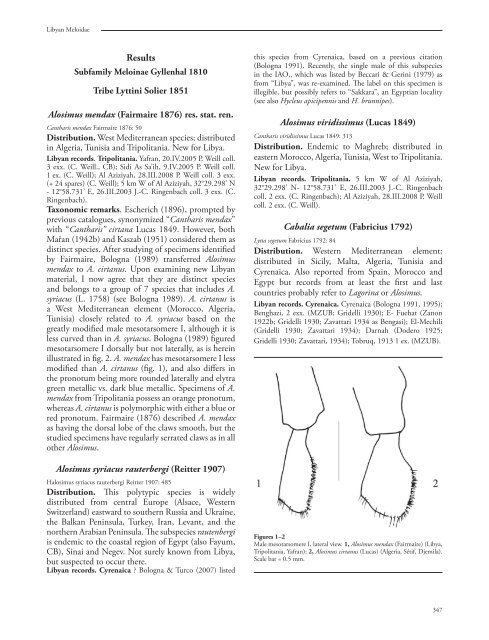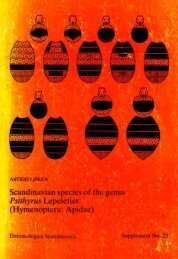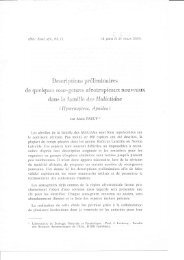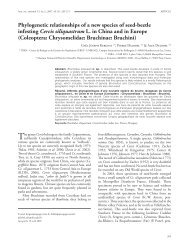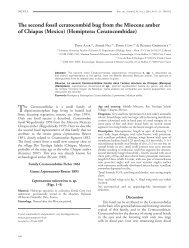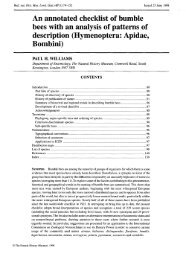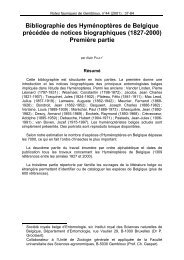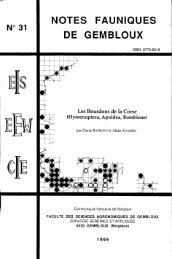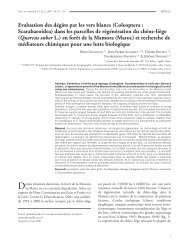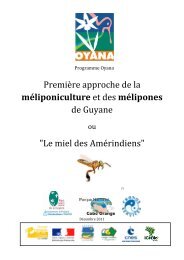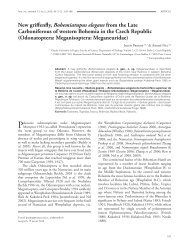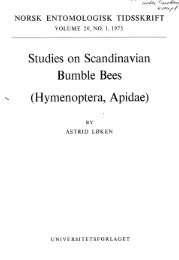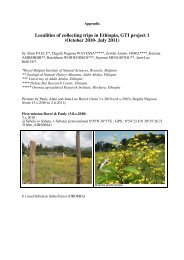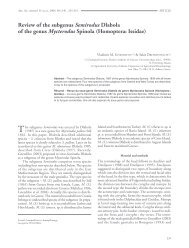Bologna 2009 - Beetles and Rock Art in Libya - Free
Bologna 2009 - Beetles and Rock Art in Libya - Free
Bologna 2009 - Beetles and Rock Art in Libya - Free
You also want an ePaper? Increase the reach of your titles
YUMPU automatically turns print PDFs into web optimized ePapers that Google loves.
<strong>Libya</strong>n Meloidae<br />
Results<br />
Subfamily Melo<strong>in</strong>ae Gyllenhal 1810<br />
Tribe Lytt<strong>in</strong>i Solier 1851<br />
Alosimus mendax (Fairmaire 1876) res. stat. ren.<br />
Cantharis mendax Fairmaire 1876: 50<br />
Distribution. West Mediterranean species; distributed<br />
<strong>in</strong> Algeria, Tunisia <strong>and</strong> Tripolitania. New for <strong>Libya</strong>.<br />
<strong>Libya</strong>n records. Tripolitania. Yafran, 20.IV.2005 P. Weill coll.<br />
3 exx. (C. Weill., CB); Sidi As Sa’ih, 9.IV.2005 P. Weill coll.<br />
1 ex. (C. Weill); Al Aziziyah, 28.III.2008 P. Weill coll. 3 exx.<br />
(+ 24 spares) (C. Weill); 5 km W of Al Aziziyah, 32°29.298’ N<br />
- 12°58.731’ E, 26.III.2003 J.-C. R<strong>in</strong>genbach coll. 3 exx. (C.<br />
R<strong>in</strong>genbach).<br />
Taxonomic remarks. Escherich (1896), prompted by<br />
previous catalogues, synonymized “Cantharis mendax”<br />
with “Cantharis” cirtana Lucas 1849. However, both<br />
Mařan (1942b) <strong>and</strong> Kaszab (1951) considered them as<br />
dist<strong>in</strong>ct species. After study<strong>in</strong>g of specimens identified<br />
by Fairmaire, <strong>Bologna</strong> (1989) transferred Alosimus<br />
mendax to A. cirtanus. Upon exam<strong>in</strong><strong>in</strong>g new <strong>Libya</strong>n<br />
material, I now agree that they are dist<strong>in</strong>ct species<br />
<strong>and</strong> belongs to a group of 7 species that <strong>in</strong>cludes A.<br />
syriacus (L. 1758) (see <strong>Bologna</strong> 1989). A. cirtanus is<br />
a West Mediterranean element (Morocco, Algeria,<br />
Tunisia) closely related to A. syriacus based on the<br />
greatly modified male mesotarsomere I, although it is<br />
less curved than <strong>in</strong> A. syriacus. <strong>Bologna</strong> (1989) figured<br />
mesotarsomere I dorsally but not laterally, as is here<strong>in</strong><br />
illustrated <strong>in</strong> fig. 2. A. mendax has mesotarsomere I less<br />
modified than A. cirtanus (fig. 1), <strong>and</strong> also differs <strong>in</strong><br />
the pronotum be<strong>in</strong>g more rounded laterally <strong>and</strong> elytra<br />
green metallic vs. dark blue metallic. Specimens of A.<br />
mendax from Tripolitania possess an orange pronotum,<br />
whereas A. cirtanus is polymorphic with either a blue or<br />
red pronotum. Fairmaire (1876) described A. mendax<br />
as hav<strong>in</strong>g the dorsal lobe of the claws smooth, but the<br />
studied specimens have regularly serrated claws as <strong>in</strong> all<br />
other Alosimus.<br />
Alosimus syriacus rauterbergi (Reitter 1907)<br />
Halosimus syriacus rauterbergi Reitter 1907: 485<br />
Distribution. This polytypic species is widely<br />
distributed from central Europe (Alsace, Western<br />
Switzerl<strong>and</strong>) eastward to southern Russia <strong>and</strong> Ukra<strong>in</strong>e,<br />
the Balkan Pen<strong>in</strong>sula, Turkey, Iran, Levant, <strong>and</strong> the<br />
northern Arabian Pen<strong>in</strong>sula. The subspecies rautenbergi<br />
is endemic to the coastal region of Egypt (also Fayum,<br />
CB), S<strong>in</strong>ai <strong>and</strong> Negev. Not surely known from <strong>Libya</strong>,<br />
but suspected to occur there.<br />
<strong>Libya</strong>n records. Cyrenaica ? <strong>Bologna</strong> & Turco (2007) listed<br />
this species from Cyrenaica, based on a previous citation<br />
(<strong>Bologna</strong> 1991). Recently, the s<strong>in</strong>gle male of this subspecies<br />
<strong>in</strong> the IAO,, which was listed by Beccari & Ger<strong>in</strong>i (1979) as<br />
from “<strong>Libya</strong>”, was re-exam<strong>in</strong>ed. The label on this specimen is<br />
illegible, but possibly refers to “Sakkara”, an Egyptian locality<br />
(see also Hycleus apicipennis <strong>and</strong> H. brunnipes).<br />
Alosimus viridissimus (Lucas 1849)<br />
Cantharis viridissimus Lucas 1849: 313<br />
Distribution. Endemic to Maghreb; distributed <strong>in</strong><br />
eastern Morocco, Algeria, Tunisia, West to Tripolitania.<br />
New for <strong>Libya</strong>.<br />
<strong>Libya</strong>n records. Tripolitania. 5 km W of Al Aziziyah,<br />
32°29.298’ N- 12°58.731’ E, 26.III.2003 J.-C. R<strong>in</strong>genbach<br />
coll. 2 exx. (C. R<strong>in</strong>genbach); Al Aziziyah, 28.III.2008 P. Weill<br />
coll. 2 exx. (C. Weill).<br />
Cabalia segetum (Fabricius 1792)<br />
Lytta segetum Fabricius 1792: 84<br />
Distribution. Western Mediterranean element;<br />
distributed <strong>in</strong> Sicily, Malta, Algeria, Tunisia <strong>and</strong><br />
Cyrenaica. Also reported from Spa<strong>in</strong>, Morocco <strong>and</strong><br />
Egypt but records from at least the first <strong>and</strong> last<br />
countries probably refer to Lagor<strong>in</strong>a or Alosimus.<br />
<strong>Libya</strong>n records. Cyrenaica. Cyrenaica (<strong>Bologna</strong> 1991, 1995);<br />
Benghazi, 2 exx. (MZUB; Gridelli 1930); E- Fuehat (Zanon<br />
1922b; Gridelli 1930; Zavattari 1934 as Bengasi); El-Mechili<br />
(Gridelli 1930; Zavattari 1934); Darnah (Dodero 1925;<br />
Gridelli 1930; Zavattari, 1934); Tobruq, 1913 1 ex. (MZUB).<br />
Figures 1–2<br />
Male mesotarsomere I, lateral view. 1, Alosimus mendax (Fairmaire) (<strong>Libya</strong>,<br />
Tripolitania, Yafran); 2, Alosimus cirtanus (Lucas) (Algeria, Sétif, Djemila).<br />
Scale bar = 0.5 mm.<br />
347


